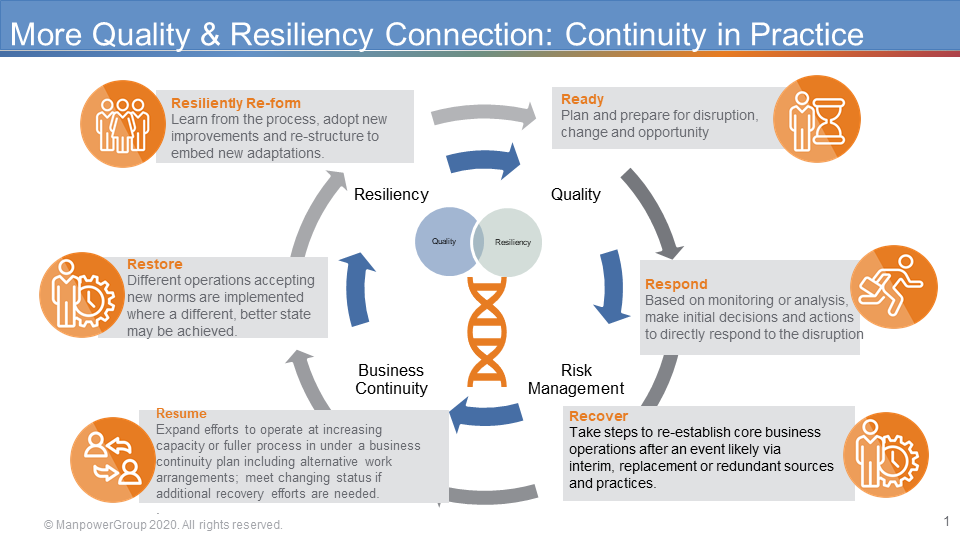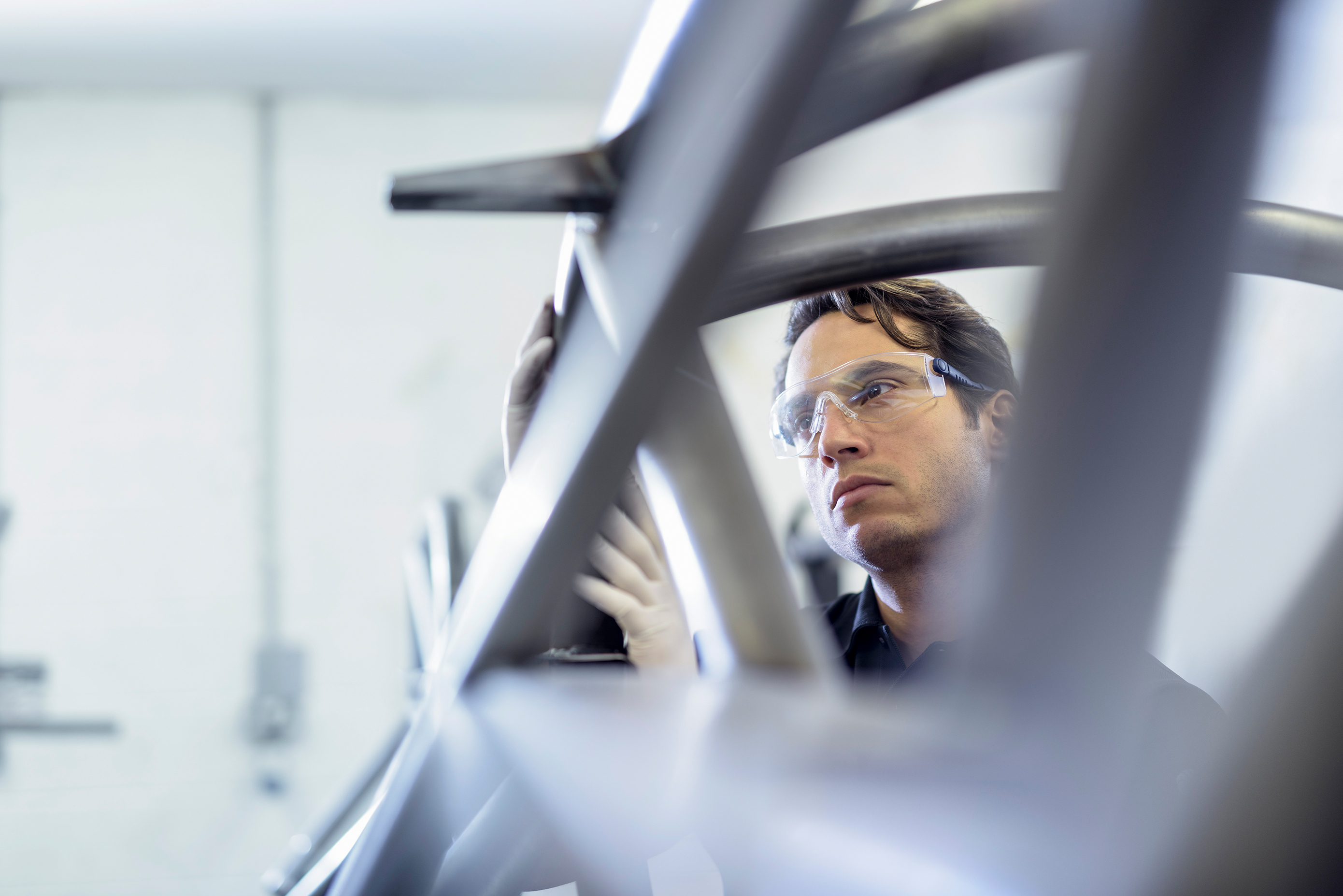Quality is a critical function in most organizations and, as my colleague Tony Del Preto pointed out in his blog it will be even more critical going forward. The question remains, though, what is the future of quality and what will add value in an era informed by not only digital technologies but with conventional rules rewritten by a global pandemic? Put another way, how should Quality managers and practitioners add value in an era which will likely have continuous disruption? I believe that Resiliency is the new value that Quality can add and that Resilience will be the vital component as we move from Quality 4.0 to Quality 5.0.
Manpower takes the view that there is connective DNA between Quality and Resilience – with shared traits… a shared ‘genetic code’ if you will. These common traits include Continuity, Adaptiveness, Data-Driven, Modern Collaboration, and Continuous Improvement. The graphic below illustrates a more structured way to think through Quality and Resiliency by looking through the lens of Business Continuity, often the go to program for disruption response.

Business Continuity (BC) practitioners often have a 4-5 phase cycle. Over the last five years, Readiness was often added to the front of the cycle, which we advocate as an essential workforce and organizational practice—a key add in our view of BC is later in the cycle and what we call Resiliently Re-forming. This is where an organization actively embeds new adaptations from what is learned and proactively develops adaptive capabilities overall. Requiring a convergence of often separated teams – Risk, Business Continuity, and Quality – those arenas share a new goal of together driving the entire cycle that make organizations more resilient and joining with other key disciplines to make it real.
So, let’s peel back the onion a bit. How are Quality roles expanding and enabling the continuity cycle and contributing to resiliency? Let’s roll through my 6 R’s on how Quality roles will expand going forward.
Readiness
Being Ready for dynamic situations – whether disasters or opportunities – takes a workforce that can prepare for more flexible work including:
- establish and leverage mobile/virtual and remote operations and the tech that supports them
- use predictive systems and practices to anticipate vulnerabilities and hot spots
- practice a mindset for the longer term that uses resources well so that recovery or change isn’t as intensive or without options
- ensures the focus can stay on the mission yet be adaptable to reorient the mission as the change dictates
- and has awareness and connection to partners and supply chains where even more vulnerability and change in the broader ecosystem can impact resilience.
Here are some roles in the Quality workforce ecosystem that we see enabling Readiness:
• Cybersecurity Workforce Managers who need to anticipate and understand which roles (like the Secure Product Life Cycle Manager) need to be recruited including those who build in quality from the start or make "secure from the start" systems and products.
• Leadership and governance across the enterprise that unites Quality with Risk and Compliance in all business value areas, from a Supply Chain Compliance Manager to an internal Quality Advisor with a Change Management Specialist focus. These are readiness roles that help an organization be ready for dynamic change.
Response
Response and Incident Management roles have a history in crisis management and critical process interventions. Mobile and virtual technologies that enable quick shifts of workforce locations, or networks, platforms and communications channels or data sources all enable response. Who’s designing these omni-access assets and working with the business on disaster recovery and the alternative work arrangements they enable? Having diverse and shared or cross trained and integrative functions is usually a benefit. Mobile and virtual readiness helps in response options. And, keeping a focus on the mission and critical processes as well as engaging partners enables the best early responses to keep the lights on, sometimes literally.
How are Quality roles expanding in Response?
• Incident Response Teams and Resource Coordinators will continue to be core roles.
• Digitally enabled Process Engineers will have to quickly adjust processes when resources and routines are disrupted.
• Infrastructure Security Architects that make secure the adjusted or transfer capacity so recovery can have solid footing are also crucial roles.
Recovery
What does it take to begin to normalize enough to increase end-to-end processes and ramp up but not usually go back to the same processes, systems, resources, and work environments? This is where we need some key capabilities that show what can anchor quality and adaptation in this stage. Of course, the ability to collect data on the adjusted situation is essential so quantitative capabilities, evidence-based decisions and providing essential data and financials enables more confident decision making. Tech-assisted operations can take the load off of manual and human resources, making flexible and scalable Automation, including line changeovers for producing different products or using different materials, even more essential.
Which roles in the Quality workforce ecosystem do we see that enable Recovery?
• Resource Managers, Business Forecasters and Schedulers are key in addition to Business Continuity Managers and team members.
• Autonomous Factory Engineers and Automation Engineers are essential recovery resources, especially as in recovery mode, a major push is on for accelerated automation as part of the process. Companies are transferring production to more automated facilities or considering automation to balance workforce loss or conflict.
Resumption
This stage is marked by hope and progress and sees us opening up more, increasing capacity, seeing alternative methods getting traction or being replaced by previous approaches as conditions allow. But most things will likely not be the same. And, if there was ever a time to be thinking of maintaining or adjusting sources of opportunities, this is it. As some sources of revenue may have dropped off or certain costs are incurred, a commercially oriented and entrepreneurial mindset can enable creative relationships, new or different sales opportunities and optimized pursuits. Collaboration is key internally and externally so integrative solutions including with partners who themselves are in change mode is important.
Which roles across the Quality workforce ecosystem do we see that enable Resumption?
• Sales Engineers can and should get creative.
• Supply Chain and Partner Manager roles that focus especially on quick turnaround changes are key.
• The Vendor/OEM Collaboration Manager is also an essential role to strengthen the areas in which an organization is Partner/Network Dependent.
Restoration
Restoration is often reserved for the stage where the new normal is in place and as full of a recovery as possible has been achieved. The ability to predict new futures is important as well as to assess new operating modes often without baselines for the newer normal. In many cases, there may be new work locations or work from home and remote management that have worked so well they become permanent. New supplier relationships or standards will likely have evolved. The workforce itself will have developed new capabilities and expectations which restoration will have to accommodate to continue engagement and newfound productivity.
Which roles in the Quality workforce ecosystem do we see that enable Restoration? Crucial will be roles that highlight the focus on cross-functional and integration tasks. We see that as being core to a fast and effective initial Recovery.
• Data Scientists to help identify better data sources and new insights for the new normal.
• Worker Experience Designers get a turn when they focus on new work arrangements that need to be made permanent and part of the new normal versus employees tolerating interim modes.
• And modernized EDI Interchange Specialists get a chance again to reconnect suppliers or new compliance activities and new or consolidated data sources.
Resiliently Reform
Resiliently Re-forming calls on all the higher value capabilities I have mentioned. What is essential here is how to institutionalize these new adaptations and make them part of the ongoing operating culture at a time when many may still feel uncertain or burnt out. From new work and job designs to team structures and communication protocols, to new products and services, reforming will literally take shape across the organization. Enabling employees to see their recent exercise in extreme flexibility as positive and as muscle development for the next change or opportunity is every leader’s role and hopefully a goal for quality professionals as part of Quality 5.0.
Other Core Capabilities
For the Quality organization of the future we believe it is crucial to cultivate the soft skills of Communication, Resilience, Integrity, Empathy, and Adaptability. These are keys to guiding the efforts to a more resilient organization. It is also crucial to remember that we are in the Digital Era and there are macro changes that you will need to consider as you think about how to best evolve and connect your quality organization – I outlined these in my blog Top 10 Digital Era Job Design Changes.
Quality’s bright and bold future is tied not only to understanding how the discipline and roles will evolve, but also what new connections and “quality adjacent” roles are forming that will allow you to better connect and help drive recovery and resiliency in your enterprise. When that happens, we are all better prepared for the next change – both new opportunities and the inevitable next disruption.






Comments